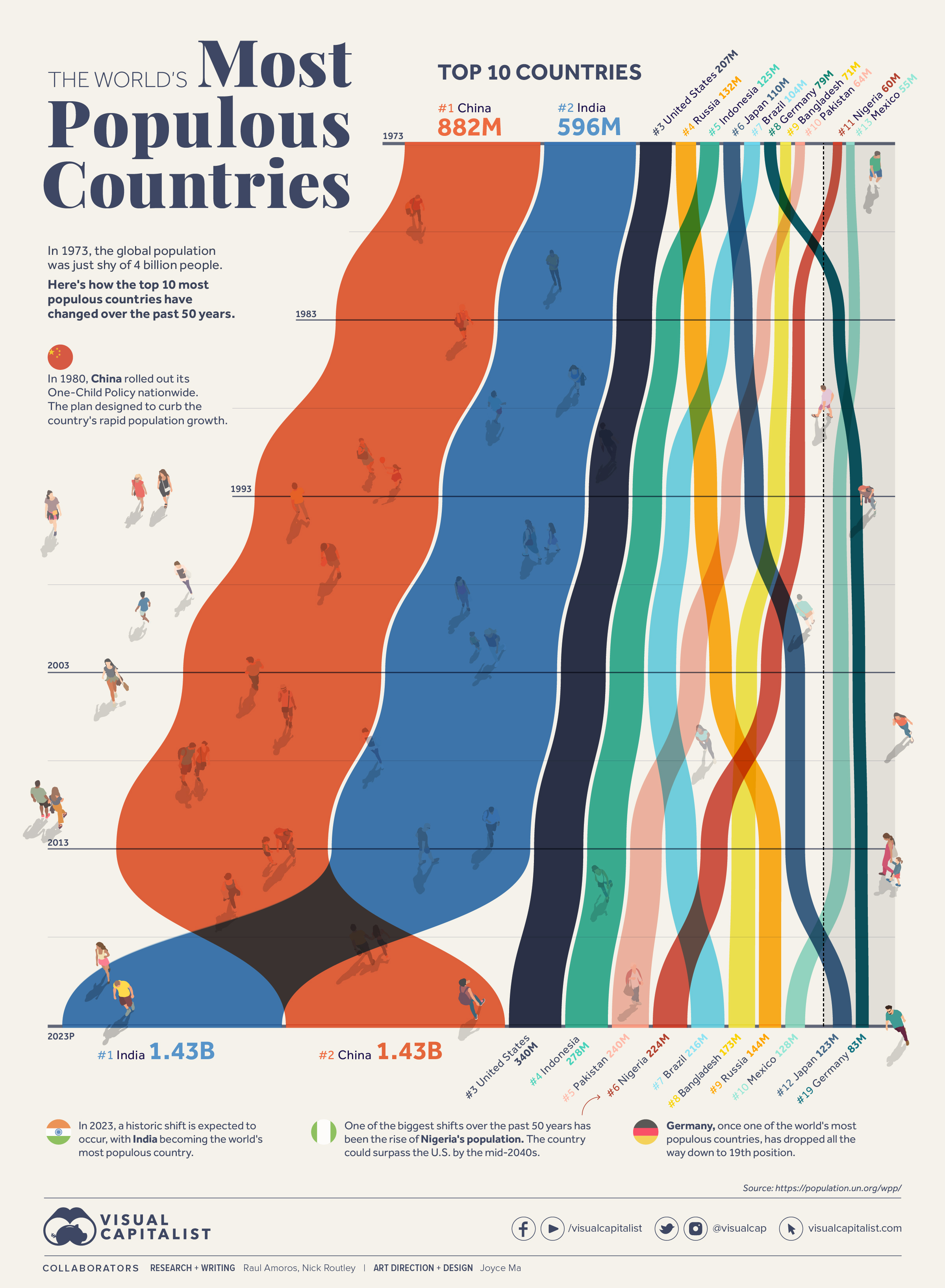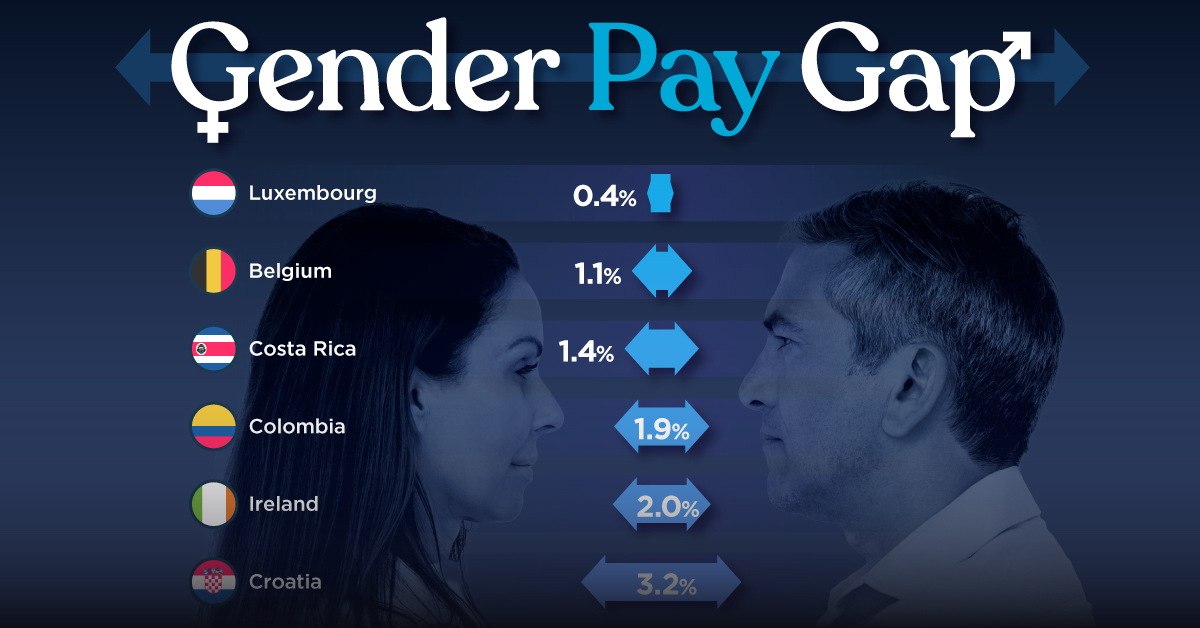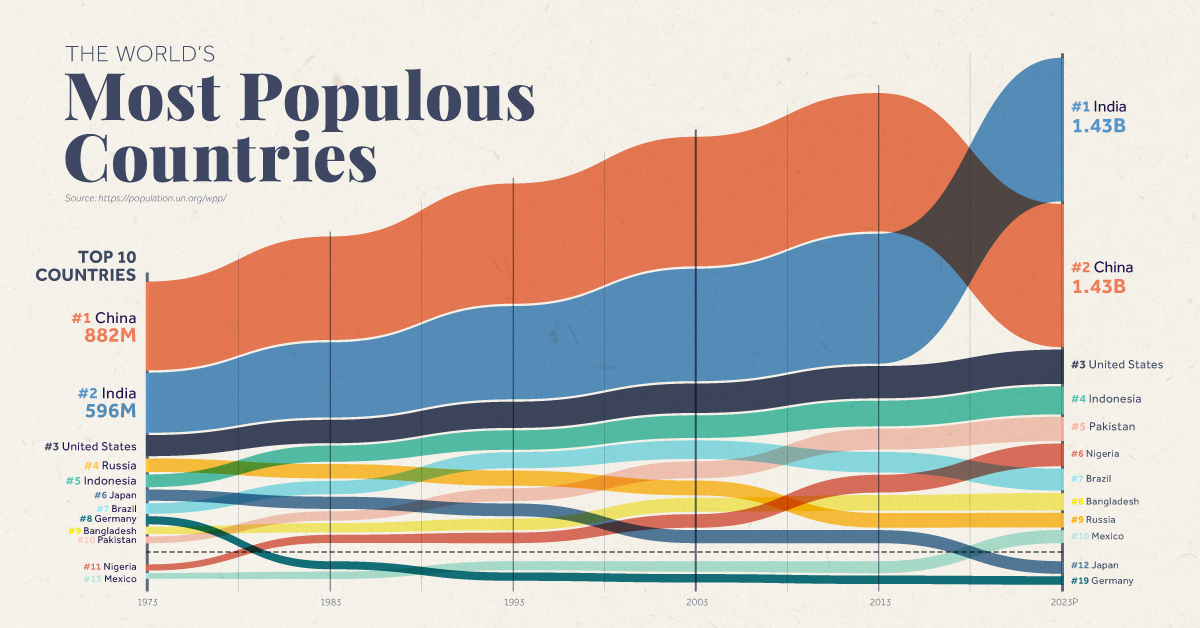Demographics
Charted: The World’s Most Populous Countries (1973–2023)

The World’s Most Populous Countries (1973–2023)
Humankind is now double the size it was in 1973.
Of course, that growth has been far from uniform, and the ranking of the world’s most populous countries continues to evolve.
Using the latest data available from the United Nations, we’ve looked at which countries have the largest share of the planet’s eight billion people.
The Top 10 Most Populous Countries
Here are the countries shown above, including how much they’ve grown over the past 50 years:
| Country | Population (1973) | Population (2023) | Change (1973–2023) |
|---|---|---|---|
| 🇨🇳 China | 881,652,084 | 1,425,671,353 | 544,019,269 |
| 🇮🇳 India | 596,107,487 | 1,428,627,666 | 832,520,179 |
| 🇺🇸 United States | 207,314,772 | 339,996,567 | 132,681,795 |
| 🇷🇺 Russia | 132,191,636 | 144,444,360 | 12,252,724 |
| 🇮🇩 Indonesia | 124,709,060 | 277,534,118 | 152,825,058 |
| 🇯🇵 Japan | 109,679,473 | 123,294,516 | 13,615,043 |
| 🇧🇷 Brazil | 103,666,906 | 216,422,450 | 112,755,544 |
| 🇩🇪 Germany | 78,667,473 | 83,294,634 | 4,627,161 |
| 🇧🇩 Bangladesh | 71,144,816 | 172,954,325 | 101,809,509 |
| 🇵🇰 Pakistan | 64,285,630 | 240,485,666 | 176,200,036 |
| 🇳🇬 Nigeria | 59,605,450 | 223,804,636 | 164,199,186 |
| 🇲🇽 Mexico | 55,228,202 | 128,455,563 | 73,227,361 |
The numbers above highlight the extreme variance in growth for these world’s most populous countries. While Germany has grown by just 6% over the past 50 years, Pakistan and Nigeria have nearly quadrupled their populations.
Half a century ago, there were only six countries with populations of over 100 million. Today, there are 15 countries past that mark, with Vietnam positioned to hit that milestone next.
The Top 20 Most Populous Countries
Things get even more interesting when we examine the top 20 most populous countries over the same time period.
| Country | Population (1973) | Rank (1973) | Population (2023) | Rank (2023) |
|---|---|---|---|---|
| 🇨🇳 China | 881,652,084 | 1 | 1,425,671,353 | 2 |
| 🇮🇳 India | 596,107,487 | 2 | 1,428,627,666 | 1 |
| 🇺🇸 United States | 207,314,772 | 3 | 339,996,567 | 3 |
| 🇷🇺Russia | 132,191,636 | 4 | 144,444,360 | 9 |
| 🇮🇩 Indonesia | 124,709,060 | 5 | 277,534,118 | 4 |
| 🇯🇵 Japan | 109,679,473 | 6 | 123,294,516 | 12 |
| 🇧🇷 Brazil | 103,666,906 | 7 | 216,422,450 | 7 |
| 🇩🇪 Germany | 78,667,473 | 8 | 83,294,634 | 19 |
| 🇧🇩 Bangladesh | 71,144,816 | 9 | 172,954,325 | 8 |
| 🇵🇰 Pakistan | 64,285,630 | 10 | 240,485,666 | 5 |
| 🇳🇬 Nigeria | 59,605,450 | 11 | 223,804,636 | 6 |
| 🇬🇧 United Kingdom | 56,166,630 | 12 | 67,736,798 | 21 |
| 🇲🇽 Mexico | 55,228,202 | 13 | 128,455,563 | 10 |
| 🇮🇹 Italy | 54,379,587 | 14 | 58,870,763 | 25 |
| 🇫🇷 France | 51,814,077 | 15 | 64,756,586 | 23 |
| 🇺🇦 Ukraine | 48,301,548 | 16 | 36,744,635 | 41 |
| 🇻🇳 Vietnam | 44,891,286 | 17 | 98,858,947 | 16 |
| 🇵🇭 Philippines | 40,406,232 | 18 | 117,337,366 | 13 |
| 🇹🇭 Thailand | 38,873,065 | 19 | 71,801,281 | 20 |
| 🇹🇷 Turkey | 38,028,236 | 20 | 85,816,192 | 18 |
| 🇪🇬 Egypt | 37,120,778 | 21 | 112,716,599 | 14 |
| 🇮🇷 Iran | 30,981,903 | 25 | 89,172,768 | 17 |
| 🇪🇹 Ethiopia | 30,694,321 | 26 | 126,527,064 | 11 |
| 🇨🇩 DRC | 21,853,908 | 32 | 102,262,812 | 15 |
Looking back 50 years ago, Nigeria was the lone African nation in the top 20. Today, it is joined by Ethiopia, Egypt, and the Democratic Republic of the Congo – all of which have experienced staggering population growth.
African nations are expected to lead population growth over the next few decades. By 2100, one quarter of the world’s people are expected to be African.
Europe is the flip side of this equation. Back in 1973, there were six European countries in this top list. Today, only Russia and Germany remain, with the latter country soon to fall out of the top 20 ranking.
Ukraine, which was shrinking, is expected to fall to at least 41st place due to the turmoil surrounding the Russian invasion of the country. Since the invasion began in February 2022, nearly 14 million border crossings have been recorded from Ukraine to other countries.
How Big Will Populations Get?
Once India becomes the world’s largest country, it will likely remain so for many decades in the future, peaking in the 2060s (unless there are substantial changes in projected growth rates). India’s peak population will stand at around 1.7 billion people.
The world’s population is expected to peak later, around the 2080s. Humanity’s peak population is expected to be about 10.5 billion.
Demographics
The Smallest Gender Wage Gaps in OECD Countries
Which OECD countries have the smallest gender wage gaps? We look at the 10 countries with gaps lower than the average.

The Smallest Gender Pay Gaps in OECD Countries
This was originally posted on our Voronoi app. Download the app for free on iOS or Android and discover incredible data-driven charts from a variety of trusted sources.
Among the 38 member countries in the Organization for Economic Cooperation and Development (OECD), several have made significant strides in addressing income inequality between men and women.
In this graphic we’ve ranked the OECD countries with the 10 smallest gender pay gaps, using the latest data from the OECD for 2022.
The gender pay gap is calculated as the difference between median full-time earnings for men and women divided by the median full-time earnings of men.
Which Countries Have the Smallest Gender Pay Gaps?
Luxembourg’s gender pay gap is the lowest among OECD members at only 0.4%—well below the OECD average of 11.6%.
| Rank | Country | Percentage Difference in Men's & Women's Full-time Earnings |
|---|---|---|
| 1 | 🇱🇺 Luxembourg | 0.4% |
| 2 | 🇧🇪 Belgium | 1.1% |
| 3 | 🇨🇷 Costa Rica | 1.4% |
| 4 | 🇨🇴 Colombia | 1.9% |
| 5 | 🇮🇪 Ireland | 2.0% |
| 6 | 🇭🇷 Croatia | 3.2% |
| 7 | 🇮🇹 Italy | 3.3% |
| 8 | 🇳🇴 Norway | 4.5% |
| 9 | 🇩🇰 Denmark | 5.8% |
| 10 | 🇵🇹 Portugal | 6.1% |
| OECD Average | 11.6% |
Notably, eight of the top 10 countries with the smallest gender pay gaps are located in Europe, as labor equality laws designed to target gender differences have begun to pay off.
The two other countries that made the list were Costa Rica (1.4%) and Colombia (1.9%), which came in third and fourth place, respectively.
How Did Luxembourg (Nearly) Eliminate its Gender Wage Gap?
Luxembourg’s virtually-non-existent gender wage gap in 2020 can be traced back to its diligent efforts to prioritize equal pay. Since 2016, firms that have not complied with the Labor Code’s equal pay laws have been subjected to penalizing fines ranging from €251 to €25,000.
Higher female education rates also contribute to the diminishing pay gap, with Luxembourg tied for first in the educational attainment rankings of the World Economic Forum’s Global Gender Gap Index Report for 2023.
See More Graphics about Demographics and Money
While these 10 countries are well below the OECD’s average gender pay gap of 11.6%, many OECD member countries including the U.S. are significantly above the average. To see the full list of the top 10 OECD countries with the largest gender pay gaps, check out this visualization.
-

 Real Estate2 weeks ago
Real Estate2 weeks agoVisualizing America’s Shortage of Affordable Homes
-

 Technology1 week ago
Technology1 week agoRanked: Semiconductor Companies by Industry Revenue Share
-

 Money1 week ago
Money1 week agoWhich States Have the Highest Minimum Wage in America?
-

 Real Estate1 week ago
Real Estate1 week agoRanked: The Most Valuable Housing Markets in America
-

 Business1 week ago
Business1 week agoCharted: Big Four Market Share by S&P 500 Audits
-

 AI1 week ago
AI1 week agoThe Stock Performance of U.S. Chipmakers So Far in 2024
-

 Misc2 weeks ago
Misc2 weeks agoAlmost Every EV Stock is Down After Q1 2024
-

 Money2 weeks ago
Money2 weeks agoWhere Does One U.S. Tax Dollar Go?


















